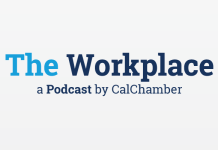![]() The California Division of Occupational Safety and Health (Cal/OSHA) is in the process of developing regulations to prevent heat illness in indoor workplaces.
The California Division of Occupational Safety and Health (Cal/OSHA) is in the process of developing regulations to prevent heat illness in indoor workplaces.
A California Chamber of Commerce-led coalition has submitted written comments and oral testimony at each step of the process encouraging Cal/OSHA to establish rational policies that are not unnecessarily burdensome on employers while minimizing the risk of heat illness to workers in indoor workplaces.
Comments on the latest draft of the standard, released on January 29, are due on February 22.
The background information below is excerpted from the CalChamber 2019 Business Issues and Legislative Guide article written by CalChamber Policy Advocate Marti Fisher before her retirement at the beginning of this year.
- In 2016 the Legislature passed SB 1167 (Mendoza; D-Artesia), directing Cal/OSHA to develop a regulation to prevent heat illness amongst indoor workers and submit it to the Cal/OSHA Standards Board by January 1, 2019. Formal rulemaking was to follow.
- In 2017 and 2018, Cal/OSHA held three stakeholder work group meetings, known as Advisory Committees, to review draft rules. Subsequently, three additional drafts were released to which stakeholders submitted written comments.
- A draft rule was circulated by Cal/OSHA to stakeholders October 24, 2018 with written comments submitted by the CalChamber-led coalition on November 20, 2018.
- All drafts of the rule and public written comments are available at www.dir.ca.gov/dosh/doshreg/Heat-illness-prevention-indoors/.
Background
In 2005, California became the first state—and still the only state in the nation—to adopt a heat illness prevention standard to protect outdoor workers (California Code of Regulations, Title 8, Section 3395). The outdoor heat illness prevention standard requires employers to provide outdoor workers with water, shade, rest breaks, and training. Known as the high heat provisions, additional requirements apply when the outdoor temperature exceeds 95 degrees.
In 2016, CalChamber and a large coalition of businesses opposed SB 1167, which sought to establish a regulation to prevent heat illness for indoor workers. The coalition maintained that a specific regulation is unnecessary because current regulations (Title 8, Section 3203 Illness and Injury Prevention Program) require employers to identify and address workplace hazards, including the risk of heat illness in indoor workplaces.
Impact on Business
Cal/OSHA intends to classify all workplaces as either indoor or outdoor. The new regulation will apply to all indoor workplaces across all industries. However, some indoor workplaces will not be subject to the requirements if the temperatures are below the threshold, which as of the October 24, 2018 draft is in most cases 82 degrees.
The rule generally follows the framework adopted for outdoor heat illness prevention Section 3395 (water, rest, shade, training, written plan), to minimize the burden of compliance on employers, particularly those with both indoor and outdoor workplaces.
CalChamber’s primary concerns with the proposed rule are as follows:
• Many employers have both outdoor and indoor workplaces, with some or all employees transitioning between both. Therefore, indoor and outdoor rules must be harmonized so that employers with both indoor and outdoor workplaces can comply by integrating the plans into one heat illness prevention plan.
• The most recent proposal defines “indoor” essentially as a space under a ceiling and enclosed along its perimeter. This definition does not contemplate structures with chain link fences, guardrails or partial walls along perimeters. A clear and specific definition is required so that employers can identify a workplace as indoor or outdoor.
• The manner in which vehicles and equipment will be handled (for example, forklifts operated inside a warehouse, or outside, and tractors with fully or partially enclosed cabs) could present significant challenges for employers. Pick-up and delivery operations where employees are in and out of vehicles that may not be air conditioned and may or may not be fully enclosed also require clear definition and direction for employers to properly apply the rules.
Today, employers subject to the outdoor heat rule include their equipment operators and vehicle drivers in their outdoor program. Cal/OSHA has not yet proposed a workable policy.
• Engineering controls for heat exposure in indoor workplaces must be not only feasible, but reasonable for employers to implement while protecting employees.
• Record retention should conform to general record retention requirements of the Injury and Illness Prevention Program (IIPP)—one year. In Cal/OSHA’s October 24, 2018 proposal, records of indoor temperature assessments would have to be retained for more than 30 years.
Anticipated Action in 2019
The statutory deadline for Cal/OSHA to submit a proposal to the Cal/OSHA Standards Board was January 1, 2019. Subsequent to the board’s receiving the proposal, many steps will be taken before formal rulemaking, which is anticipated to begin sometime in 2019.
As it has throughout the pre-rulemaking process, the CalChamber-led coalition will continue to provide thoughtful, rational comments and regulatory language to Cal/OSHA to ensure clarity that will lead to effective compliance by employers while improving employee safety.
CalChamber Position
California employers take the safety and health of their employees very seriously. CalChamber supports workplace safety policies that ensure new rules are feasible, based on sound science and assist the regulated community in its compliance efforts while protecting employees. CalChamber will continue to advocate for sound policy regarding heat illness prevention for indoor workplaces, and continue to oppose policies that are unnecessarily complex and burdensome for employers.
To participate in CalChamber’s stakeholder working group, please send an email of interest with your contact information to heatillness@calchamber.com.


